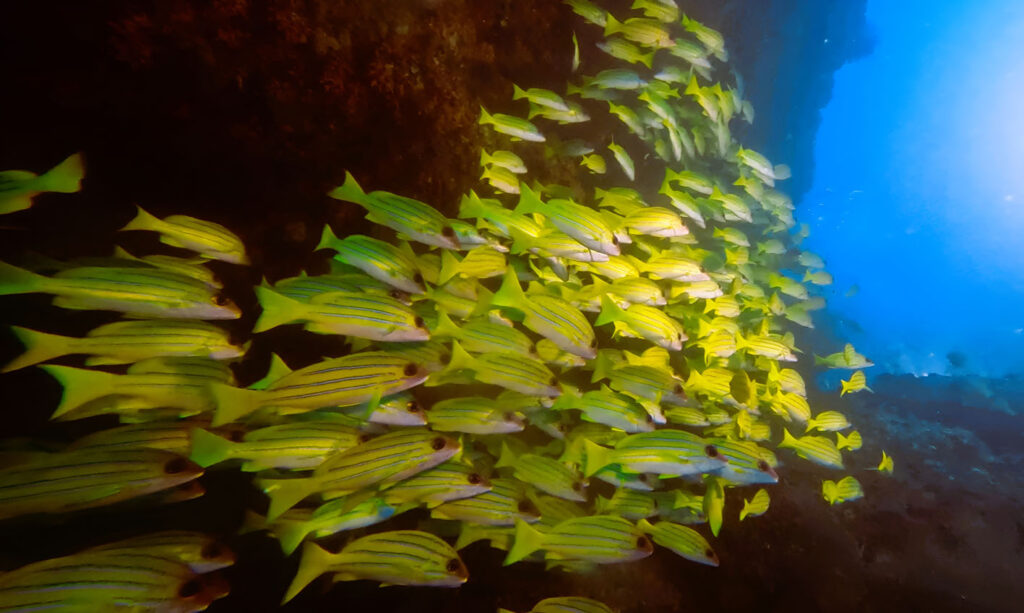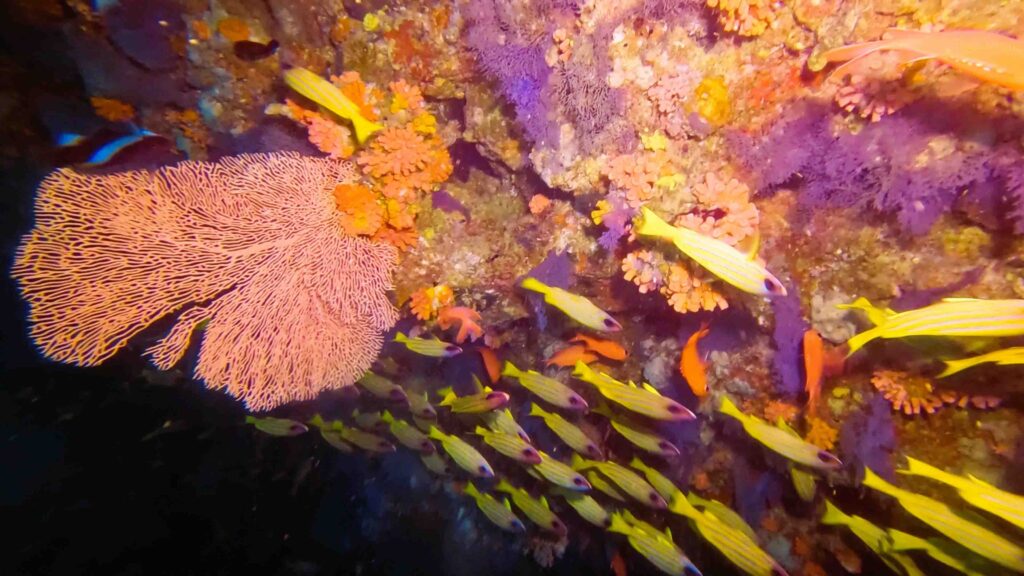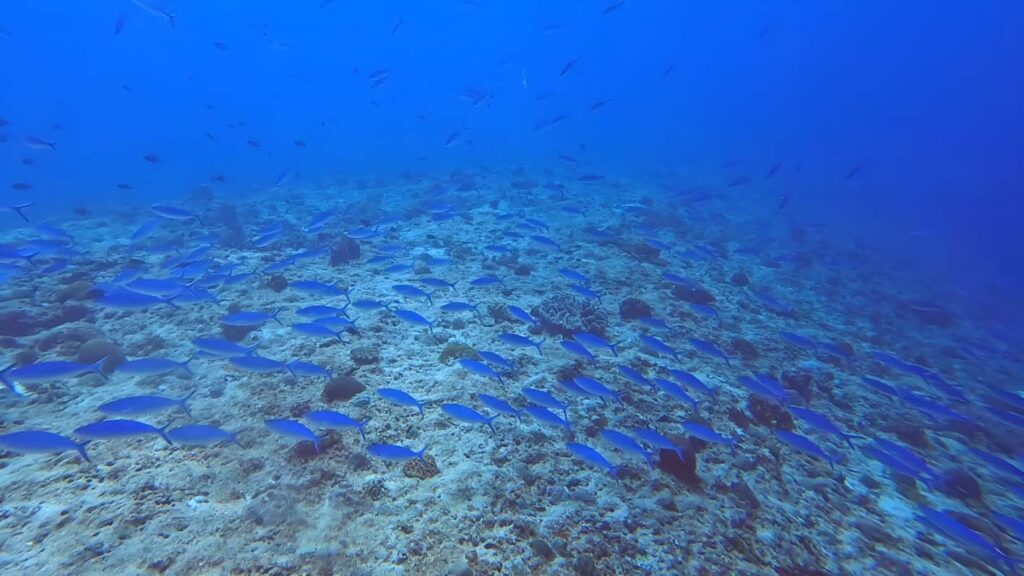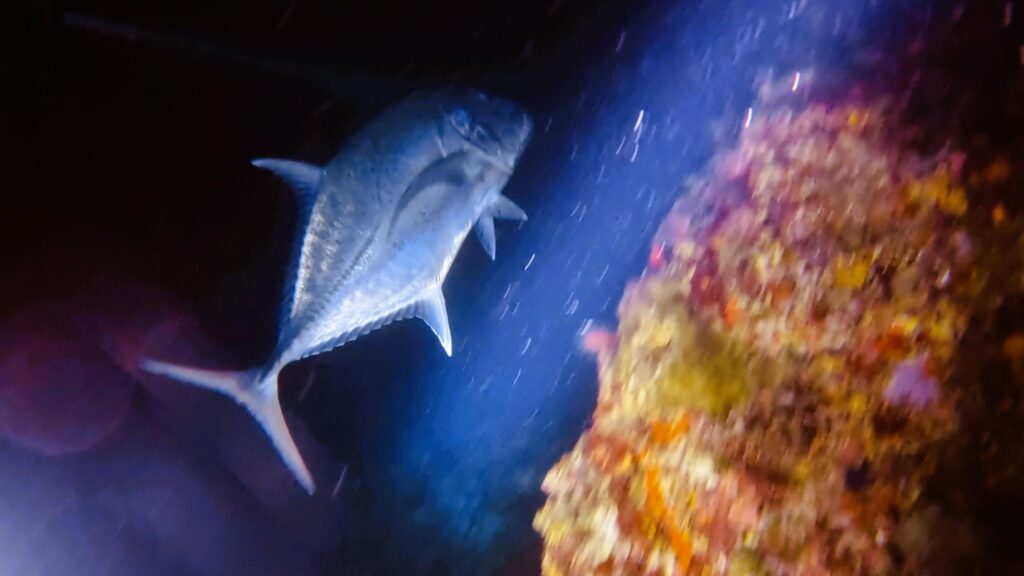KUDA RAH THILA
Probably the most peculiar of the dive sites in the Maldives are the thilas. These are coral formations whose highest part is only a few meters deep. This means that, in addition to corals, all kinds of life thrive here.

In this case we are talking about 14 to 25 meters deep. And here the most characteristic life are the large banks of bluestripe snappers. What stands out most about them are not the stripes that give them their name, as they are blurred among their intense yellow color, which predominates along their entire length. A bright color that extends over much of the thila wall all the way to the bottom. They are everywhere and there are thousands of them!

It is an exciting sensation to enter one of these shoals and let yourself be carried away by the hundreds of fish swimming around you. It seems that they are so used to divers that we are just one of the shoal.

To brighten up this beautiful scene, the walls of the thila are covered with all kinds of colorful corals. It is highly recommended to bring a good flashlight and turn it on from time to time to appreciate all the rainbow this universe has to offer.

THUNDUFUSHI THILA
One of the most defining characteristics of Maldivian style diving is the currents. It’s a good idea to bring a current hook so you can anchor and watch the show. However, Thundufushi is one of those classic drift dives. Drifting with the current is surely one of the most enjoyable sensations you can experience while diving. Some people prefer to swim against the current, but that’s to suit all tastes.

In this thila we have spectacular visibility, so we can see in their splendor, as well as spectacular coral formations, turtles and huge schools of fusiliers. These fish are actually silver, but depending on the point of view, they reflect the blue color of the ocean and turn the thila wall into a bluish continuation of the deeper bottom.

EMBOODHOO THILA
We were in the central atolls in December, when visibility is not as good as in the February to May season. However, as you move further away from the interior of the atoll and closer to the open ocean, visibility improves considerably. This is the case at Emboodhoo Thila. Its crystal clear waters with visibility of more than 30 meters allow us to see all kinds of marine life with an unmatched luminosity.

Its deepest part shows us its multicoloured fish and corals. We can follow the huge banks of multicoloured fish to the highest part of the thila, very close to the surface. Here we encounter something bigger, such as hawksbill turtles.

At this point it is important to distinguish the difference between a bank (also named school) and a shoal. They are often used synonymously, but schooling always refers to fish of the same species. In contrast, shoaling can refer to groupings of fish of different species that intermix as they swim together.

FESDHOO WRECK
There are few natural wrecks left in the Maldives. Time and monsoons have taken their toll. However, the resorts have taken it upon themselves to provide us with some of them to include in our dive safari.

Fesdhoo is a relatively small wreck, but it is not usually very crowded. However, with a group of 20 people, which is usual on any boat, it is enough to go all the way around it.

Visibility is usually not very good, however, the boat rests gently in a natural position on a white sandy bottom at a depth of 30 meters. This makes it much easier to explore.

This sunken ship has a very interesting feature. We are able to observe the proliferation of corals all over its surface, some of them of considerable size. Nature is making its way, and in just a few years. Among these corals we can look for moray eels, nudibranchs and some small fish. From time to time, it is a good idea to turn towards the blue to find some lost manta or shark. After a few days of diving, this dive is a relaxing way to start the day.

FISH HEAD
This is one of the best view balconies I’ve ever seen. The capricious nature of this thila has turned a large indentation in the reef into a natural viewpoint for divers. From here, we can see lots of sharks cruising placidly a few meters down, beyond the depth limit that the Nitrox allows us. Surely, they have learned how to make themselves safe from humans by getting out of their reach.


After the shark show, on our way back to the surface, we can still see some very interesting things. For example, huge table coral formations spread all along the ascent wall and on top of the thila. If we are lucky, we may even find a giant moray eel hiding underneath one of them.

As if all this were not enough, this area is also a meeting place for huge banks of fusiliers. We can stay for a while with neutral buoyancy while hundreds of them swim around us with capricious maneuvers in perfect coordination, among themselves and to avoid us. It is an indescribable sensation, like being in the eye of the storm. We can even hear their thousands of fins whistling in unison as they pass almost brushing against us…


MAAYA THILA
This place has a well-deserved reputation for its double life. It is a peaceful place by day, where you can find hundreds of clownfish crouching among the anemones, combined with giant table corals. By night, however, it is a different place. Its waters are transformed into a night hunting ground, where jackfishes and sharks move swiftly in spasmodic movements to get their prey. So fast that it is mission impossible to get a good picture. A picture is worth a thousand words…





Practical tips and logistics for diving in the Maldives
Choose the Right Time
The best time to dive in the Maldives is from November to April, when the dry season brings clearer water and optimal visibility. During these months, the sea is calm, making it easier to access the most impressive dive sites. Particularly recommended from February to May, when conditions are usually better. Whenever possible, you should avoid the monsoon season from May to October, especially June and July. Many safaris and dive centers close during these two months, although some are open all year round. In any case, the richness of these waters is sure to be enjoyable at any time.
Accommodation Selection
The Maldives has two main types of accommodation: liveaboards and luxury resorts.
It is highly recommended to choose a specialized dive boat, where we will have excellent accommodation with dives in more interesting spots for a week or more. This also does not guarantee that you will be alone underwater, as there are many dive safari providers in the Maldives. Most allow non-divers and the use of Nitrox is common.
On the other hand, we can choose to stay at a resort with its own dive center. This will not only give you direct access to exclusive dive excursions, but will also allow you to interact with experienced divers and local guides who know the best sites.
Certification and Security
We must make sure that we have our diving certification up to date before the trip. In general, the Maldivian ocean has conditions that require a certain level. At a minimum Advanced OWD, and the more experience we have, the more we will enjoy it.
Currents are a factor to be taken into account, and you will need to be prepared for this and to carry a current hook and buoy. Most operators require this. It is also worth mentioning that the guides, especially on liveaboards, have thousands of dives experience, which ensures safety at all times.
Most life aboard use Nitrox. You need to make sure what air mix you will be using on the boat you have booked, to be at the level of the group and to have the proper certification. Most dives have a maximum depth of 30 meters, but the depth is much deeper. We can get lost following the sharks and go down too deep. Be especially careful about this if you are diving with Nitrox.
Adequate Equipment
Although many dive centers and boats in the Maldives offer equipment rental, bringing your own equipment can enhance your comfort and diving experience. If you are not cold, a 3mm wetsuit may be enough. Although many recommend a 5mm for diving for a week at a time. The dive computer is mandatory everywhere and the buoy is usually mandatory too due to the currents and the type of diving, where there are no reference buoys anchored to the bottom, but rather the guides release the buoy at the end of each dive. If we deviate from the group, it is important to carry one. A current hook is recommended in case we encounter a current that is too strong. There are even some dives where the main attraction is to anchor to the bottom and let the current rock you as you watch the sharks pass in front of you. Remember to anchor the hook in an area where there are no corals or damage to anything. Unfortunately, there are too many such areas due to the passage of thousands of divers.
Conservation of the Marine Environment
The Maldives are known for its commitment to marine conservation. Let’s be responsible divers and avoid touching corals or disturbing marine life. We should not chase sharks, manta rays… They will approach us and if they do so freely we will be able to enjoy them much longer. If we chase them or dazzle them, they will move away and we lose the opportunity to dive with them. If we miss a good photo because we are a bit far away, we will certainly have many other opportunities to take advantage of. It is interesting to find a balance between enjoying the dives and taking the best photos or videos.
It is very recommendable to consider participating in beach clean-ups, bottom clean-up dives, or marine conservation awareness courses offered by many dive centres and dive boats. Our participation will not only enrich our experience, but also contribute to the protection of this fragile ecosystem.

Explore Diverse Dive Sites
The Maldives has a wide variety of dive sites, from tranquil reefs to exciting channels with strong currents that attract large pelagics. If you’re in a resort, don’t limit yourself to sites close to your accommodation; consider taking boat dive safaris that allow you to explore remote atolls and enjoy a wider diversity of marine life.
If you choose a liveaboard it will be the boat that determines the route, although you can choose your preferred route before booking. The most popular is the central atolls route, featured in this article, as it is the closest to the capital, Malé, where the international airport is located. The southern route is also very interesting, as it is further away from “civilization”. Very soon we will also have the opportunity to enjoy it in SportMarketMagazine.
Health preparations, currency and communications
The Maldives is a very healthy and safe destination. Since it is a luxury spot, wherever we go, the conditions will be optimal. Just make sure your dive insurance is up to date.
Dollars, euros and credit cards are accepted almost everywhere. If you carry enough cash and a credit card, you can avoid any further formalities.
If your phone supports it, you can buy an eSim before you leave home. In the arrivals area of the airport, you’ll find places to buy a card from the local communications company, which for about 30-40 dollars will give you enough gigabytes for a week. 4G coverage is pretty good everywhere. If Wi-Fi is not free at your accommodation, this is a good option.
The Maldivian authorities require digital identification before entering and leaving the country. Currently, completion of the IMUGA form is a must. As regulations change, it’s best to make sure you have what you need at all times.
Hydration and nutrition
Staying well hydrated is crucial to avoid decompression and other dive-related problems. Drink plenty of water before and after your dives and avoid alcohol or caffeinated drinks which can dehydrate you. The high prices of alcoholic beverages in most places can be a major deterrent effect 😉. Eating light, nutritious food can also help you maintain your energy without feeling too full or uncomfortable during the dive. Take a supplement with you if you need it. Remember that due to the currents, physical effort may be greater than in other situations.
Underwater Photography
If you are interested in underwater photography, the Maldives is the perfect place to practice and capture stunning images of marine life. Invest in a good underwater camera and familiarize yourself with its use before your trip. Taking videos and then taking pictures of them is a good option to not miss any detail and enjoy the dives while capturing the best moments. All photos and videos in this report have been taken with a GoPro Hero 10, with underwater housing and orange filter. Compact, light, resistant, good quality iamges, easy to use and has all the accessories needed for underwater.

Bonus tip: remember to attach your camera to your jacket with a carabiner and steel ring. This will allow you to release it with confidence if you need your hands free, making sure you don’t lose it. Don’t use a lanyard attached to your wrist, nor any other type of pressure or adhesive attachment, which could come loose in a current or hit. A lot of cameras lay on the seabed because of this…
Education and learning
Take the opportunity to learn more about the underwater world through specialized courses that many centers offer, such as fish identification, biology or underwater photography. These courses not only enrich your experience, but also improve your skills as a diver and help you become more aware of where you are. Carrying a good underwater wildlife guide in your suitcase is also very useful. Pictolife offers guides that are quite complete for their small size, with photos and species names in 5 languages, they are compact and with plastic sheets, waterproof guaranteed.
Respect Local Rules and the Environment
The Maldives is a Muslim country with specific cultural norms that must be respected. It is advisable to inform yourself about the appropriate dress code and rules of conduct, especially when visiting inhabited islands. In addition, we can actively participate in environmental conservation by avoiding the use of single-use plastics and following responsible diving guidelines.

